Critical Analysis of Uganda's Environmental Problems: A Report
VerifiedAdded on 2023/01/12
|5
|1188
|46
Report
AI Summary
This report delves into the environmental challenges faced by Uganda, highlighting issues such as population growth, deforestation, climate change, and the exploration of alternative fuel sources and oil. It examines the role of USAID in addressing these problems by building capacity within Ugandan institutions and communities. USAID's focus includes biodiversity conservation, climate change adaptation, and mitigating the environmental impact of oil and gas exploration. The report provides an overview of Uganda's geographical and climatic characteristics, including its topography, rainfall patterns, and geology, which are crucial for understanding the context of these environmental challenges. The report also references several studies and research papers to support the analysis of the complex environmental landscape of Uganda.
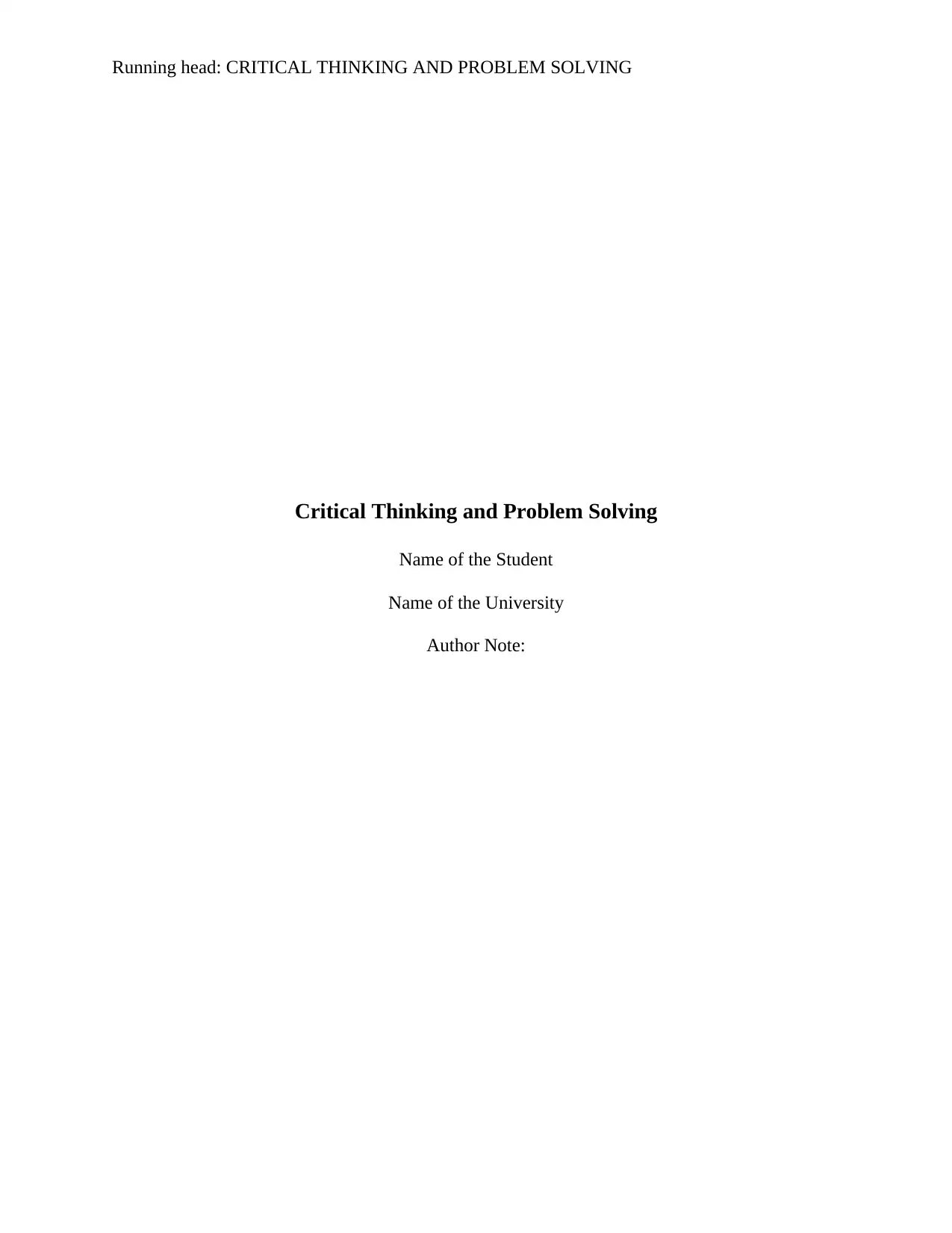
Running head: CRITICAL THINKING AND PROBLEM SOLVING
Critical Thinking and Problem Solving
Name of the Student
Name of the University
Author Note:
Critical Thinking and Problem Solving
Name of the Student
Name of the University
Author Note:
Paraphrase This Document
Need a fresh take? Get an instant paraphrase of this document with our AI Paraphraser
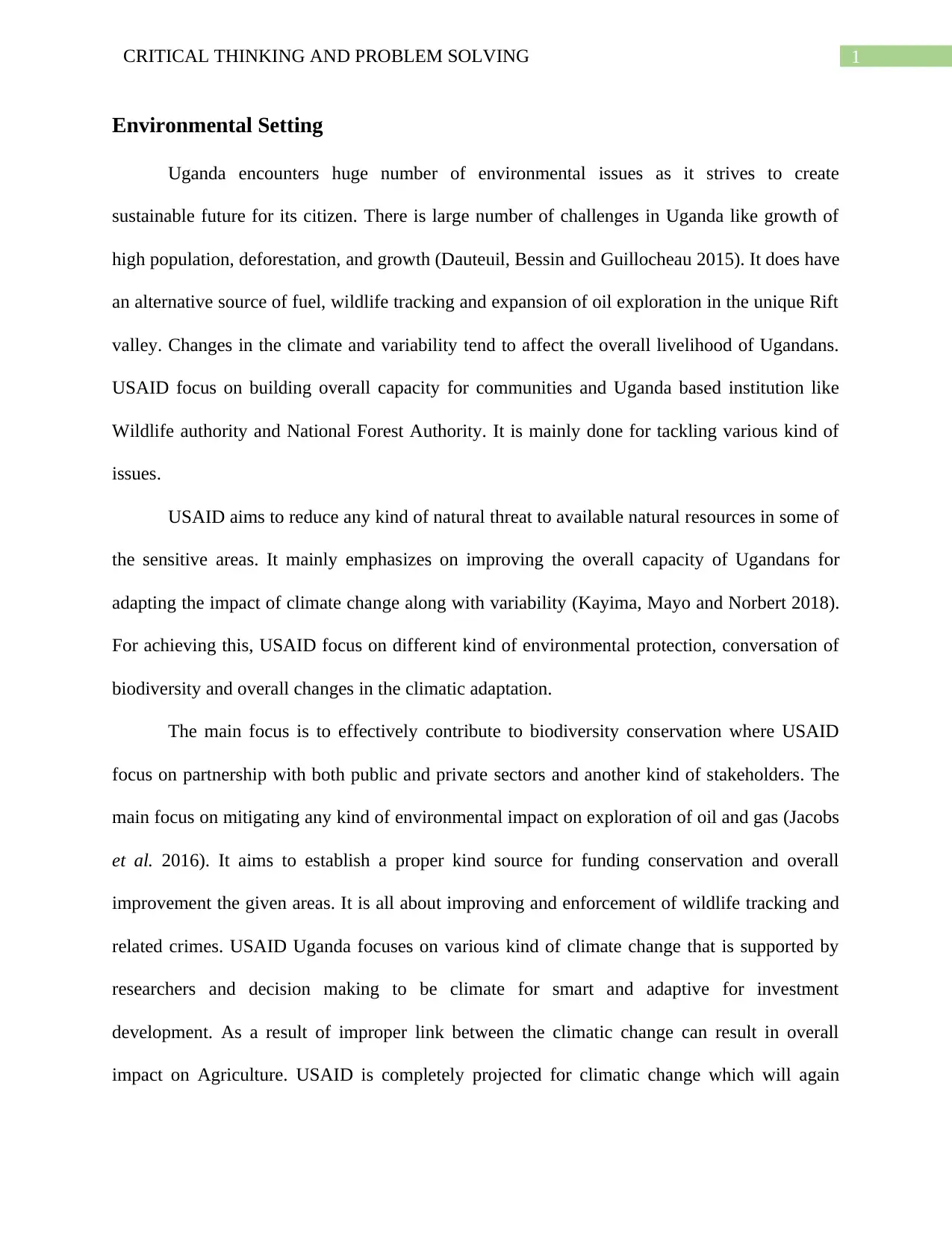
1CRITICAL THINKING AND PROBLEM SOLVING
Environmental Setting
Uganda encounters huge number of environmental issues as it strives to create
sustainable future for its citizen. There is large number of challenges in Uganda like growth of
high population, deforestation, and growth (Dauteuil, Bessin and Guillocheau 2015). It does have
an alternative source of fuel, wildlife tracking and expansion of oil exploration in the unique Rift
valley. Changes in the climate and variability tend to affect the overall livelihood of Ugandans.
USAID focus on building overall capacity for communities and Uganda based institution like
Wildlife authority and National Forest Authority. It is mainly done for tackling various kind of
issues.
USAID aims to reduce any kind of natural threat to available natural resources in some of
the sensitive areas. It mainly emphasizes on improving the overall capacity of Ugandans for
adapting the impact of climate change along with variability (Kayima, Mayo and Norbert 2018).
For achieving this, USAID focus on different kind of environmental protection, conversation of
biodiversity and overall changes in the climatic adaptation.
The main focus is to effectively contribute to biodiversity conservation where USAID
focus on partnership with both public and private sectors and another kind of stakeholders. The
main focus on mitigating any kind of environmental impact on exploration of oil and gas (Jacobs
et al. 2016). It aims to establish a proper kind source for funding conservation and overall
improvement the given areas. It is all about improving and enforcement of wildlife tracking and
related crimes. USAID Uganda focuses on various kind of climate change that is supported by
researchers and decision making to be climate for smart and adaptive for investment
development. As a result of improper link between the climatic change can result in overall
impact on Agriculture. USAID is completely projected for climatic change which will again
Environmental Setting
Uganda encounters huge number of environmental issues as it strives to create
sustainable future for its citizen. There is large number of challenges in Uganda like growth of
high population, deforestation, and growth (Dauteuil, Bessin and Guillocheau 2015). It does have
an alternative source of fuel, wildlife tracking and expansion of oil exploration in the unique Rift
valley. Changes in the climate and variability tend to affect the overall livelihood of Ugandans.
USAID focus on building overall capacity for communities and Uganda based institution like
Wildlife authority and National Forest Authority. It is mainly done for tackling various kind of
issues.
USAID aims to reduce any kind of natural threat to available natural resources in some of
the sensitive areas. It mainly emphasizes on improving the overall capacity of Ugandans for
adapting the impact of climate change along with variability (Kayima, Mayo and Norbert 2018).
For achieving this, USAID focus on different kind of environmental protection, conversation of
biodiversity and overall changes in the climatic adaptation.
The main focus is to effectively contribute to biodiversity conservation where USAID
focus on partnership with both public and private sectors and another kind of stakeholders. The
main focus on mitigating any kind of environmental impact on exploration of oil and gas (Jacobs
et al. 2016). It aims to establish a proper kind source for funding conservation and overall
improvement the given areas. It is all about improving and enforcement of wildlife tracking and
related crimes. USAID Uganda focuses on various kind of climate change that is supported by
researchers and decision making to be climate for smart and adaptive for investment
development. As a result of improper link between the climatic change can result in overall
impact on Agriculture. USAID is completely projected for climatic change which will again
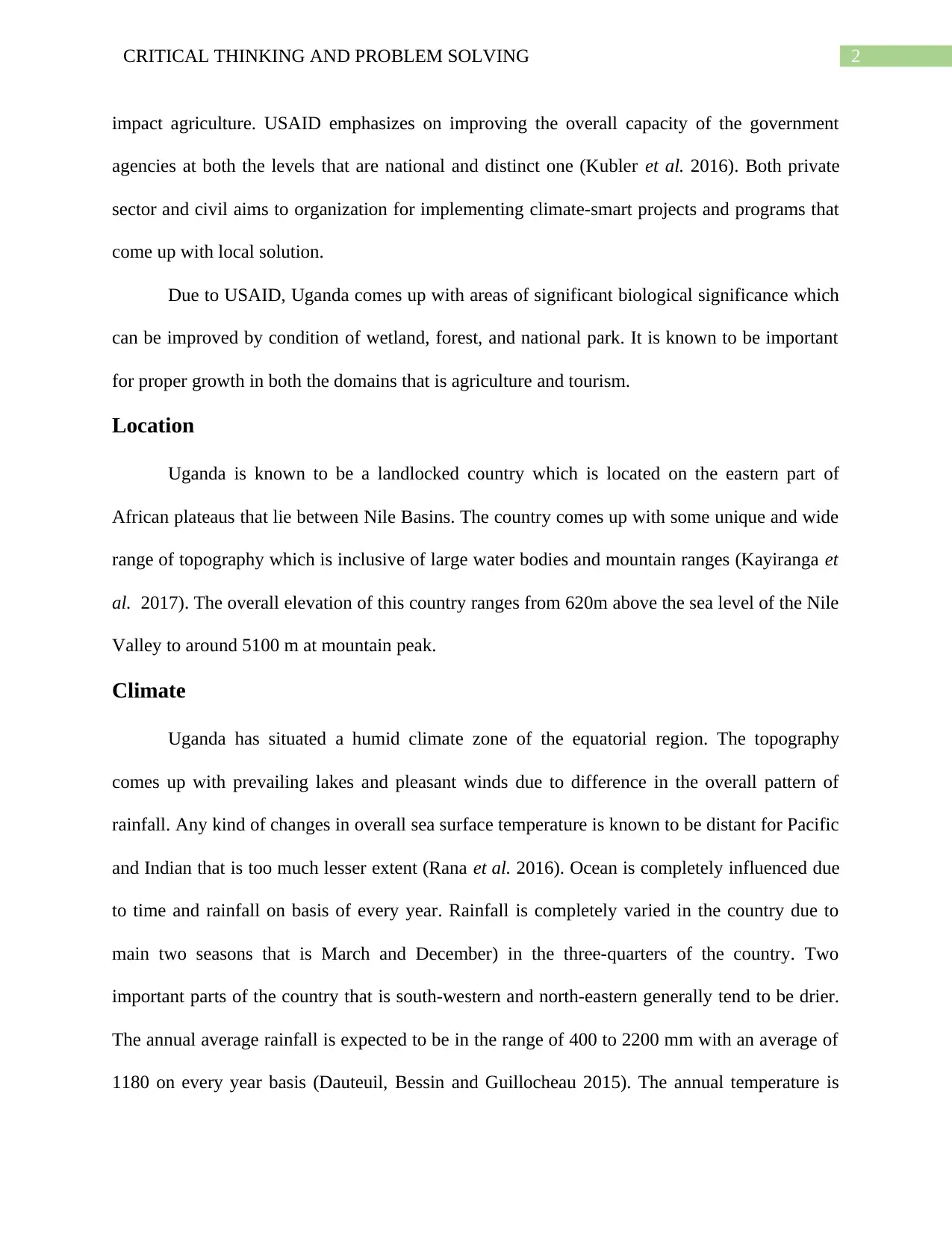
2CRITICAL THINKING AND PROBLEM SOLVING
impact agriculture. USAID emphasizes on improving the overall capacity of the government
agencies at both the levels that are national and distinct one (Kubler et al. 2016). Both private
sector and civil aims to organization for implementing climate-smart projects and programs that
come up with local solution.
Due to USAID, Uganda comes up with areas of significant biological significance which
can be improved by condition of wetland, forest, and national park. It is known to be important
for proper growth in both the domains that is agriculture and tourism.
Location
Uganda is known to be a landlocked country which is located on the eastern part of
African plateaus that lie between Nile Basins. The country comes up with some unique and wide
range of topography which is inclusive of large water bodies and mountain ranges (Kayiranga et
al. 2017). The overall elevation of this country ranges from 620m above the sea level of the Nile
Valley to around 5100 m at mountain peak.
Climate
Uganda has situated a humid climate zone of the equatorial region. The topography
comes up with prevailing lakes and pleasant winds due to difference in the overall pattern of
rainfall. Any kind of changes in overall sea surface temperature is known to be distant for Pacific
and Indian that is too much lesser extent (Rana et al. 2016). Ocean is completely influenced due
to time and rainfall on basis of every year. Rainfall is completely varied in the country due to
main two seasons that is March and December) in the three-quarters of the country. Two
important parts of the country that is south-western and north-eastern generally tend to be drier.
The annual average rainfall is expected to be in the range of 400 to 2200 mm with an average of
1180 on every year basis (Dauteuil, Bessin and Guillocheau 2015). The annual temperature is
impact agriculture. USAID emphasizes on improving the overall capacity of the government
agencies at both the levels that are national and distinct one (Kubler et al. 2016). Both private
sector and civil aims to organization for implementing climate-smart projects and programs that
come up with local solution.
Due to USAID, Uganda comes up with areas of significant biological significance which
can be improved by condition of wetland, forest, and national park. It is known to be important
for proper growth in both the domains that is agriculture and tourism.
Location
Uganda is known to be a landlocked country which is located on the eastern part of
African plateaus that lie between Nile Basins. The country comes up with some unique and wide
range of topography which is inclusive of large water bodies and mountain ranges (Kayiranga et
al. 2017). The overall elevation of this country ranges from 620m above the sea level of the Nile
Valley to around 5100 m at mountain peak.
Climate
Uganda has situated a humid climate zone of the equatorial region. The topography
comes up with prevailing lakes and pleasant winds due to difference in the overall pattern of
rainfall. Any kind of changes in overall sea surface temperature is known to be distant for Pacific
and Indian that is too much lesser extent (Rana et al. 2016). Ocean is completely influenced due
to time and rainfall on basis of every year. Rainfall is completely varied in the country due to
main two seasons that is March and December) in the three-quarters of the country. Two
important parts of the country that is south-western and north-eastern generally tend to be drier.
The annual average rainfall is expected to be in the range of 400 to 2200 mm with an average of
1180 on every year basis (Dauteuil, Bessin and Guillocheau 2015). The annual temperature is
⊘ This is a preview!⊘
Do you want full access?
Subscribe today to unlock all pages.

Trusted by 1+ million students worldwide
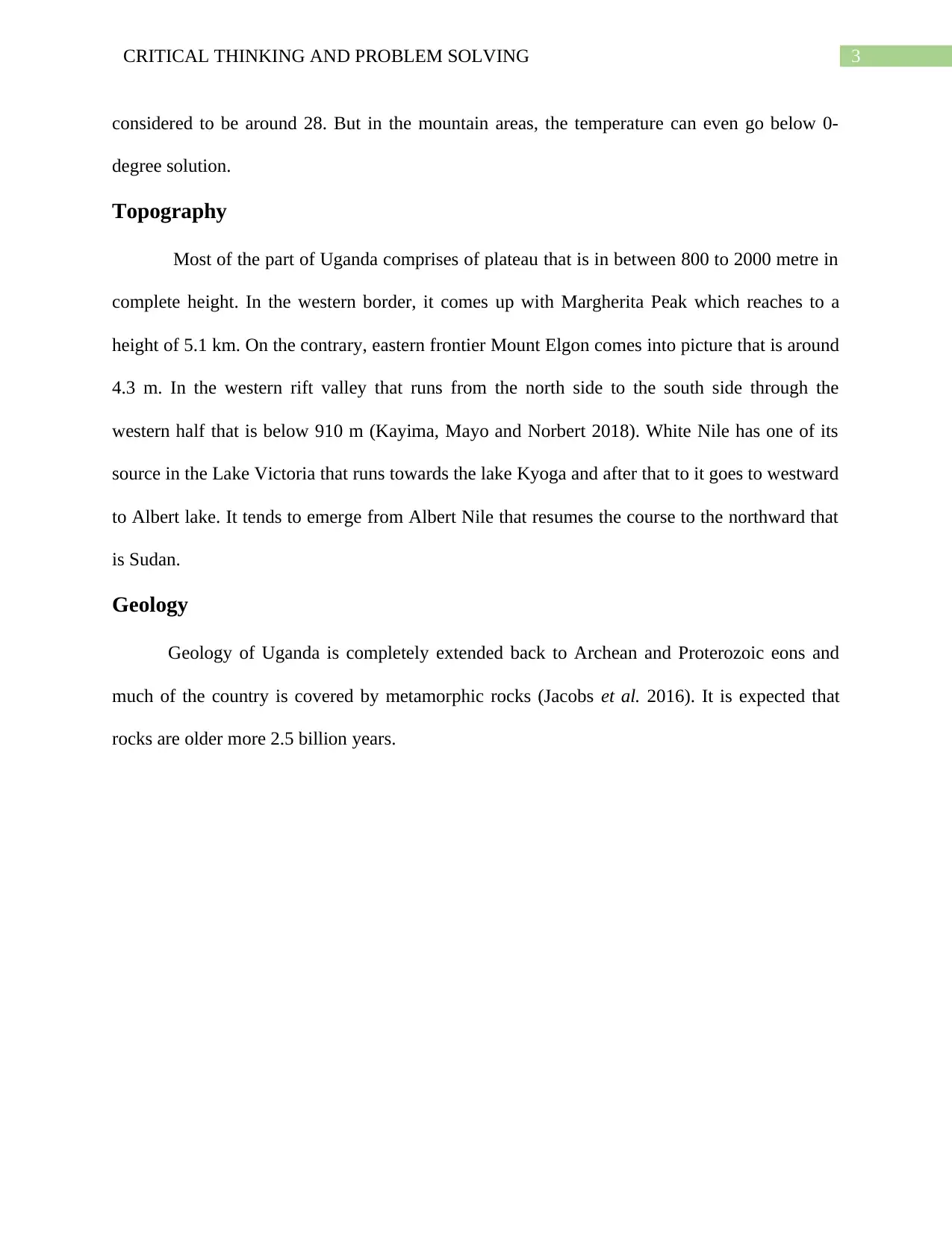
3CRITICAL THINKING AND PROBLEM SOLVING
considered to be around 28. But in the mountain areas, the temperature can even go below 0-
degree solution.
Topography
Most of the part of Uganda comprises of plateau that is in between 800 to 2000 metre in
complete height. In the western border, it comes up with Margherita Peak which reaches to a
height of 5.1 km. On the contrary, eastern frontier Mount Elgon comes into picture that is around
4.3 m. In the western rift valley that runs from the north side to the south side through the
western half that is below 910 m (Kayima, Mayo and Norbert 2018). White Nile has one of its
source in the Lake Victoria that runs towards the lake Kyoga and after that to it goes to westward
to Albert lake. It tends to emerge from Albert Nile that resumes the course to the northward that
is Sudan.
Geology
Geology of Uganda is completely extended back to Archean and Proterozoic eons and
much of the country is covered by metamorphic rocks (Jacobs et al. 2016). It is expected that
rocks are older more 2.5 billion years.
considered to be around 28. But in the mountain areas, the temperature can even go below 0-
degree solution.
Topography
Most of the part of Uganda comprises of plateau that is in between 800 to 2000 metre in
complete height. In the western border, it comes up with Margherita Peak which reaches to a
height of 5.1 km. On the contrary, eastern frontier Mount Elgon comes into picture that is around
4.3 m. In the western rift valley that runs from the north side to the south side through the
western half that is below 910 m (Kayima, Mayo and Norbert 2018). White Nile has one of its
source in the Lake Victoria that runs towards the lake Kyoga and after that to it goes to westward
to Albert lake. It tends to emerge from Albert Nile that resumes the course to the northward that
is Sudan.
Geology
Geology of Uganda is completely extended back to Archean and Proterozoic eons and
much of the country is covered by metamorphic rocks (Jacobs et al. 2016). It is expected that
rocks are older more 2.5 billion years.
Paraphrase This Document
Need a fresh take? Get an instant paraphrase of this document with our AI Paraphraser
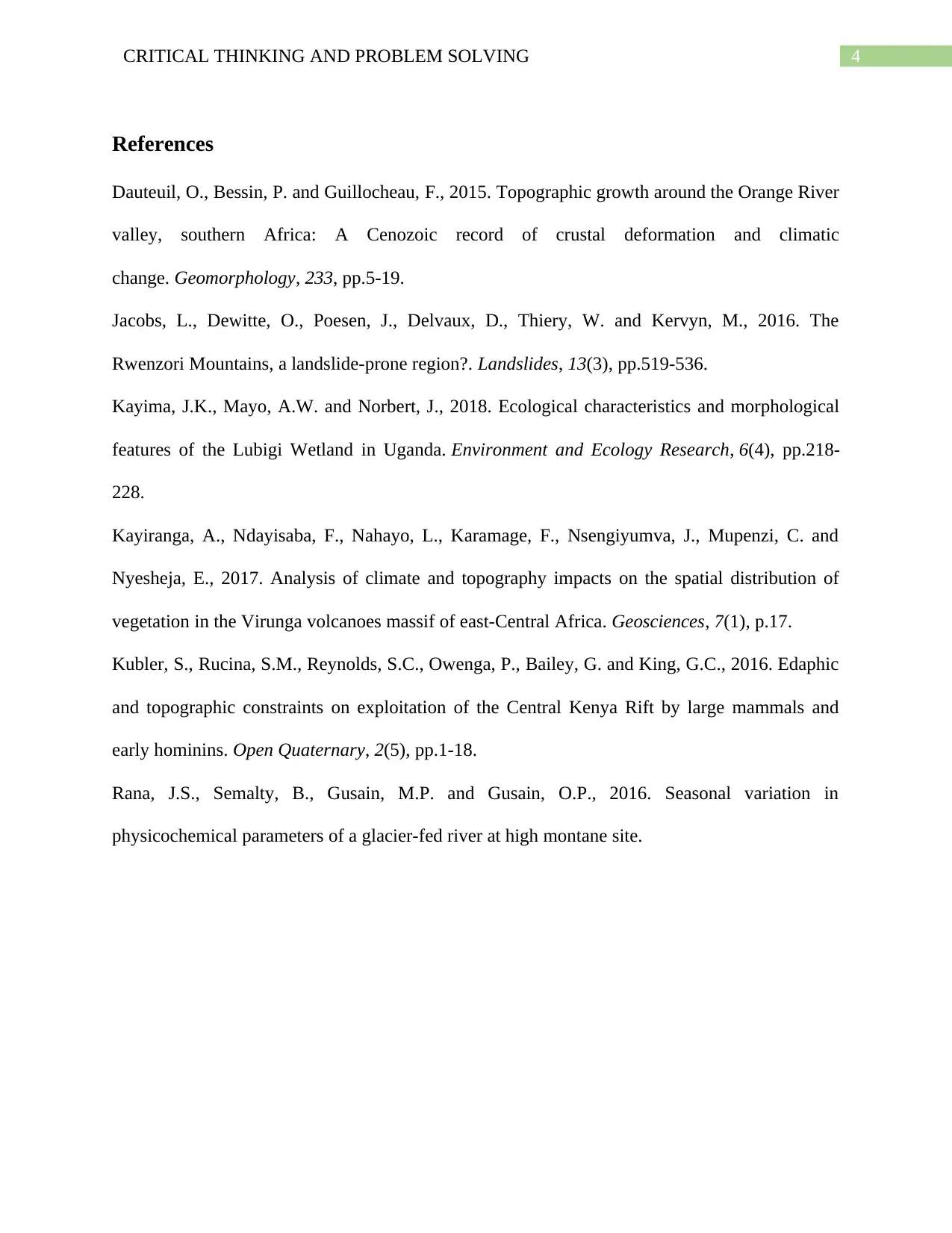
4CRITICAL THINKING AND PROBLEM SOLVING
References
Dauteuil, O., Bessin, P. and Guillocheau, F., 2015. Topographic growth around the Orange River
valley, southern Africa: A Cenozoic record of crustal deformation and climatic
change. Geomorphology, 233, pp.5-19.
Jacobs, L., Dewitte, O., Poesen, J., Delvaux, D., Thiery, W. and Kervyn, M., 2016. The
Rwenzori Mountains, a landslide-prone region?. Landslides, 13(3), pp.519-536.
Kayima, J.K., Mayo, A.W. and Norbert, J., 2018. Ecological characteristics and morphological
features of the Lubigi Wetland in Uganda. Environment and Ecology Research, 6(4), pp.218-
228.
Kayiranga, A., Ndayisaba, F., Nahayo, L., Karamage, F., Nsengiyumva, J., Mupenzi, C. and
Nyesheja, E., 2017. Analysis of climate and topography impacts on the spatial distribution of
vegetation in the Virunga volcanoes massif of east-Central Africa. Geosciences, 7(1), p.17.
Kubler, S., Rucina, S.M., Reynolds, S.C., Owenga, P., Bailey, G. and King, G.C., 2016. Edaphic
and topographic constraints on exploitation of the Central Kenya Rift by large mammals and
early hominins. Open Quaternary, 2(5), pp.1-18.
Rana, J.S., Semalty, B., Gusain, M.P. and Gusain, O.P., 2016. Seasonal variation in
physicochemical parameters of a glacier-fed river at high montane site.
References
Dauteuil, O., Bessin, P. and Guillocheau, F., 2015. Topographic growth around the Orange River
valley, southern Africa: A Cenozoic record of crustal deformation and climatic
change. Geomorphology, 233, pp.5-19.
Jacobs, L., Dewitte, O., Poesen, J., Delvaux, D., Thiery, W. and Kervyn, M., 2016. The
Rwenzori Mountains, a landslide-prone region?. Landslides, 13(3), pp.519-536.
Kayima, J.K., Mayo, A.W. and Norbert, J., 2018. Ecological characteristics and morphological
features of the Lubigi Wetland in Uganda. Environment and Ecology Research, 6(4), pp.218-
228.
Kayiranga, A., Ndayisaba, F., Nahayo, L., Karamage, F., Nsengiyumva, J., Mupenzi, C. and
Nyesheja, E., 2017. Analysis of climate and topography impacts on the spatial distribution of
vegetation in the Virunga volcanoes massif of east-Central Africa. Geosciences, 7(1), p.17.
Kubler, S., Rucina, S.M., Reynolds, S.C., Owenga, P., Bailey, G. and King, G.C., 2016. Edaphic
and topographic constraints on exploitation of the Central Kenya Rift by large mammals and
early hominins. Open Quaternary, 2(5), pp.1-18.
Rana, J.S., Semalty, B., Gusain, M.P. and Gusain, O.P., 2016. Seasonal variation in
physicochemical parameters of a glacier-fed river at high montane site.
1 out of 5
Your All-in-One AI-Powered Toolkit for Academic Success.
+13062052269
info@desklib.com
Available 24*7 on WhatsApp / Email
![[object Object]](/_next/static/media/star-bottom.7253800d.svg)
Unlock your academic potential
Copyright © 2020–2025 A2Z Services. All Rights Reserved. Developed and managed by ZUCOL.